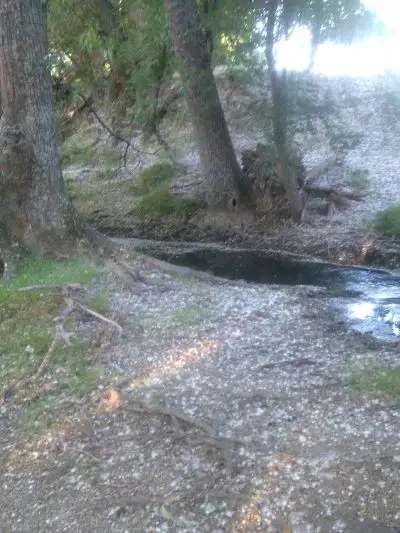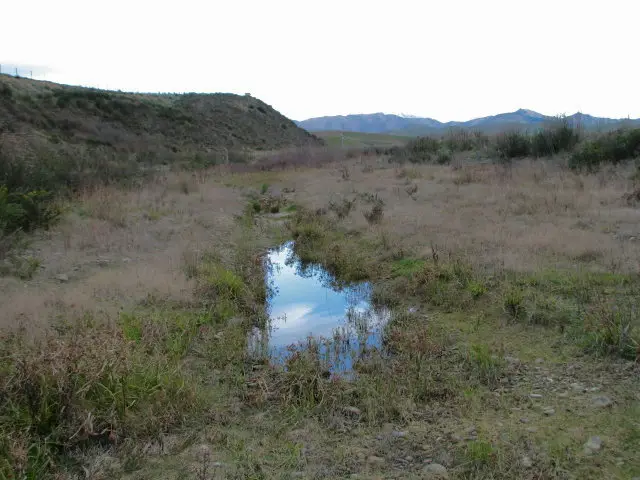Every year, countless trout and other fish get trapped as surface flows dwindle and streams dry. is I have been rescuing trapped fish from drying pools since I was a child. Every spring a small stream which flows through my childhood farm starts to dry.
The flow retreats underground faster than the fish expect, and many find themselves trapped in isolated pockets of water. Within weeks, even these last remaining pools will be dry. On hot days, water levels can drop surprisingly fast. The stuck fish do not have a chance.
What kills most trout is not the lack of water, but the quality. As the water levels drop. The temperature rises, and the algae blooms begin. Soon the trouts home will be a warm, slightly stagnant soup and not at all appealing. Large trout are usually the first to die.
Luckily for my local fish, I monitor the retreating water levels. As soon as the water levels are low enough, I intervene and try to relocate as many stuck fish as possible. Every year, there seems to be different sizes and types of fish needing saving. Some years I rescue dozens of eels and baitfish. One year I was able to rescue 32 juvenile, and two mature brown trout. The two mature fish then spent several years living beneath our access bridge and even spawned one winter before succumbing to low oxygen levels during a massive drought.

Do’s and Don’t s of rescuing trout and other fish
Ask permission from local authorities before attempting a rescue. It might be against the law.
- Ask permission from local authorities before attempting a rescue. It might be against the law.
- Do try to rescue the fish as soon as possible, every day which passes more fish die
- Monitor the streams closely, the pools can dry fast.
- Don’t move rescue fish to a different catchment or pond.
- Don’t leave the fish sitting in buckets or holder tanks longer than absolutely necessary.
- Don’t overfill the buckets, fish can jump out.
- Never transfer fish to a different catchment.
Rescuing small numbers of fish
I keep things simple; I use a large trout landing net which I use to scoop up bigger fish. I then store the fish in a couple of large buckets. Every few minutes I empty the fish from the buckets into a much larger drum I keep on the back of my pickup truck.
I fill the drum about halfway with fresh aquifer water (non-treated), and mix it slightly with river water. I fear moving fish directly from stagnant, warm pond water to crystal clear cold well water will be too much of a shock. Hence why I blend the two waters together.
If I am only moving a few fish a few miles upstream I do not use an aerator. I have found the drum water contains enough oxygen to keep them alive. If there are a lot of fish, I will make several trips. When I rescue trout, I use an aerator. They need more oxygen than eels and minnows.
If I have to keep the trout in the drum for an extended period, that is when I install an aerator. That guarantees there will be a ready supply of oxygen.
Saving a large number of trout
When there is a large number of trout needing rescuing. A couple of drums on the back of a pickup is not enough. These bigger rescues are usually a team effort. My local freshwater angling club, fund raised for a fish transporter trailer which we now have access to use.
This purpose-built trailer holds several hundred gallons of water and has permanent aerators in place. With such a trailer, we can rescue a lot of fish and transport them a long distance. The local fish and game stores the trailer for the club at their facility.
From the trailer, the local fish and game decides what to do with the rescued fish. Sometimes, they are stored temporarily in a hatchery or used to top up a depleted stretch of water.
By far the best way to catch trapped trout is with a elecofisher. These stuns the fish, allowing them to be scooped up and put into the holding tank. Elecofisher are usually only accessible by fishery researchers and not by members of the public.
Never leave a trout behind, have a second look
After the first rescue attempt, I always check back several times. As the pool shrinks in size, any remaining fish will become confined to a much smaller area. Sometimes, I will rescue 30 or 40 fish during my first attempt.
I then will return the next day, hoping to catch the last couple of strugglers.. and end up rescuing another 20 or 30 fish. Sometimes I even rescue trout which were able to avoid my net the previous day. Fish have an amazing ability to squeeze between stones and beneath the mud, making them easy to miss.
I return every day until the pool has dried up. Even, when I am too late to rescue trout I often find juvenile eels alive in the mud.
Always release fish near where you caught them.
Unless under instructions from some authority, do not move fish between catchments. Try to release them into permanent water as close to where you rescued them as possible.
I do this for several reasons but most importantly it prevents the spread of unwanted organisms between rivers. Trout now shares our waterways with many pest plants, animals and diseases. When moving fish other organisms can easily catch a ride.
Trout themselves are even an invasive species. While they are a great sporting access, there is no denying their ability to out-compete native species. The last thing we want is to release trout in waters where they do not belong.
Nobody wants invasive species to spread into new waters.
Is it legal to rescue trout from a drying river?
Rescuing trout and other fish from drying rivers is legally a gray area. When in any doubt, it is best to ask permission first from your local fishery department. While most authorities do not have a problem with keen members of the public rescuing dying fish. It is still against the laws in many jurisdictions. I am no lawyer, and this is not legal advice. From my understanding the laws it breaks, normally falls into one of three categories.
– Catching sport fish illegal equipment. In most fisheries, trout can only be caught on a rod and line. So using a net or elecofisher to capture is certainly against the rules.
– It is often illegal to be in position of live freshwater fish, this law is in place to prevent anglers from spreading unwanted species into new catchments. Just think of the damage illegal bass releases have had on many of Maines trout ponds, or the complete collapse of many brook char streams after a release of brown trout. .
– Bag limits, catching dozens of fish still puts a rescuers above most daily bag limits.
While it is against the law, when done for the right reasons most authorities will take a sympathetic approach or even turn a blind eye. Most fisheries departments want to see the fish saved but simply lack the resources to do so themselves.
What species of fish to save?
I personally save all the fish I catch. While I enjoy to rescue trout, all native fish species are important to the health of the fishery. I rescue all native baitfish, including predatory species such as eels. If it is alive, and not a pest species I am going to save it.
Luckily, there is no pest fish in my local streams. If there was, legally speaking they must be killed and not released.
I also rescue any aquatic insects which end up in my net.

